 Backend Development
Backend Development
 PHP Tutorial
PHP Tutorial
 'Specifications' for developing SMS verification code sending function in Laravel (picture)
'Specifications' for developing SMS verification code sending function in Laravel (picture)
'Specifications' for developing SMS verification code sending function in Laravel (picture)
Laravel is a simple and elegant PHP Web development framework (PHP Web Framework). Next, through this article, I will share with you the "standard" development SMS Verification code sending function in Laravel. Friends who need it can refer to it
Laravel Introduction
Laravel is a simple and elegant PHP Web development framework (PHP Web Framework). It can free you from messy codes like noodles; it can help you build a perfect network APP, and every line of code can be concise and expressive.
Laravel already has an advanced PHP ActiveRecord implementation -- Eloquent ORM. It can easily apply "constraints" to both sides of the relationship, so that you have complete control over the data and enjoy all the conveniences of ActiveRecord. Eloquent natively supports all methods of the query builder (query-builder) in Fluent.
"Standard" development of SMS verification code sending function in LaravelRequirement scenarios
Send a "verification code" or "message notification" to your mobile phone or email.
Complete
First of all, the specification in Laravel is to use Laravel's "Message Notification", here based on the scenario is "Verification Code". This requirement is used by almost all software systems.
Create notification scene
The first step is to use php artisan make:notification to create a notification class. After the creation is successful, three notification classes already exist by default. There are three methods via, toMail and toArray. Because the verification code is sent, this control class is named VerificationCode.
Then create a verification code data model and data table migration. You can use php artisan make:model \"VerificationCode\" -m to quickly create the data model and migration directly.
ThinkSNS+ migration is as follows:
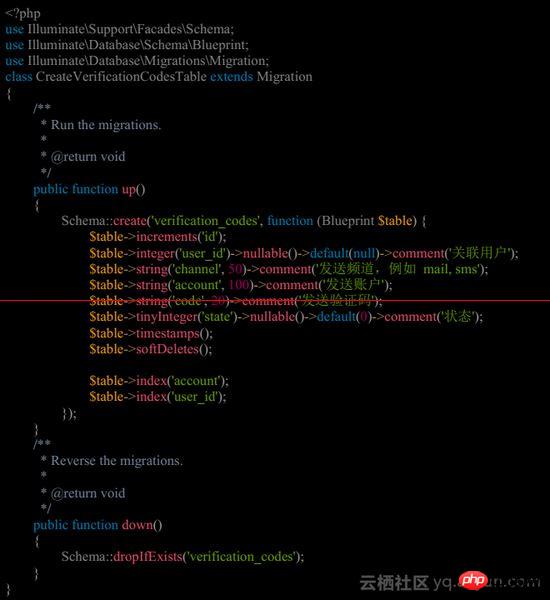
The second step is to open the dataModel class and add the Illuminate\Notifications\Notifiable trait in it :

From the code, you can see that we have also added "soft deletion". Because it is sent based on the verification code based on the mobile phone number or email, there is no need for other built-in Huahuachangzi does not need to be recorded in the "Message Notification Data Table", so in the routeNotificationFor method we choose to directly return the account (mobile phone number or email) that needs to be sent.
Join Factory Mode, send quickly
Open database/factories/ModelFactory.php and add a notification about it Factory definition of data model:
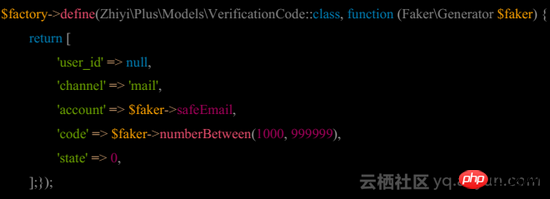
In this way, we can quickly create and send verification codes through the factory(\Zhiyi\Plus\Models\VerificationCode::class) factory function notify.
Why add notification traits to the verification code data model?
First of all, Illuminate\Notifications\Notifiable is added to the User model by Laravel by default, so you can quickly send a notification to the user through $user->notify(), but there are Such a sentence:
Remember, you may use the Illuminate\Notifications\Notifiable trait on any of your models. You are not limited to only including it on your User model.
This is Laravel The original words of the official document mean that Illuminate\Notifications\Notifiable is not only used on the User model.
So we add Illuminate\Notifications\Notifiable in the verification code model, which is fully consistent with the correct use of Laravel notifications.
Develop notification class
First of all, there is a field channel in the data table migration, which is the notification channel identifier. We can use this value to Decide how to send the verification code, and this operation is implemented in the via of the notification class:

The way we choose is to directly return the channel value, which can be any value , as long as we implement this notification channel, we can send it, and Laravel has built-in some sending channels database, mail and nexmo
Complete email verification code sending
Actually, there are very few things we have to do in this step. When producing the notification class, the toMail method has been completed, so we can directly modify its message content.
Complete sending the SMS verification code
We use the overtrue/easy-sms package to send SMS, which is an SMS sending client developed by An Zhengchao. There are many built-in SMS platforms, and the implementation is also excellent. (Tucao: Although some details are problematic, such as not passing the gateway according to the contract calling method)
First rely on SMS to send the client package composer require overtrue/easy-sms and then create a new configuration/config/sms.php, what is the content? , just follow the instructions on the easy-sms homepage to add it. First post our configuration content (in order to reduce the number of words in the article, only keep the Alibaba configuration):
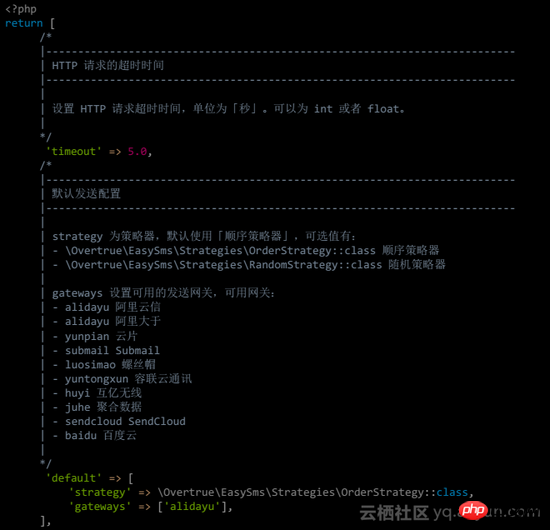
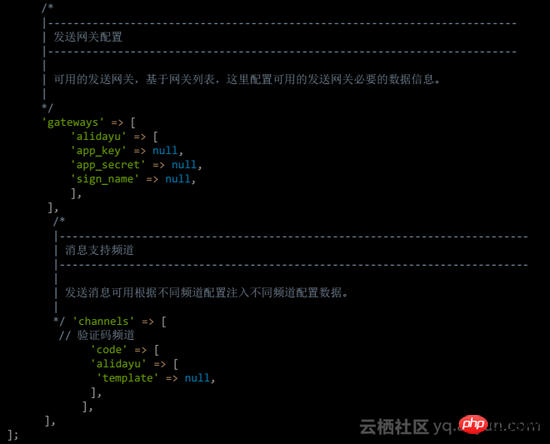
We have added a channel configuration for different scenarios, such as verification code scenario code to facilitate the messager to read the configuration.
Then open AppServiceProvider.php and add the following in register:

So far, the integration of EasySms in Laravel has been completed, but the actual function has not been developed yet. We Then look down.
Develop sms sending channel
Why develop? First of all, easy-sms supports a lot. You can consider developing a notification sending channel class for each sending platform separately, or you can only develop one SMS sending channel class. We choose to develop an SMS notification sending class through the easy-sms strategy. Mechanism to send verification codes to multiple platforms.
First, create a new app/Notifications/Channels/SmsChannel.php file. Because Laravel does not provide a generation function, you need to create this yourself. Just implement the send method. The content of SmsChannel is as follows:
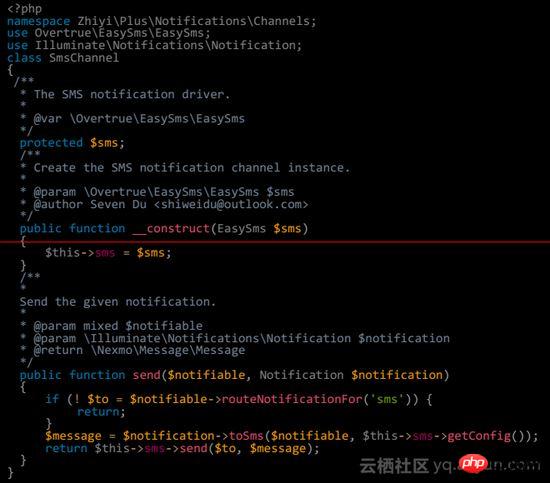
The SMS notification sending channel based on easy-sms has been completed.
Development ScenarioSend Message
This part belongs entirely to easy-sms development, we create a new VerificationCodeMessage.php , the content is as follows:
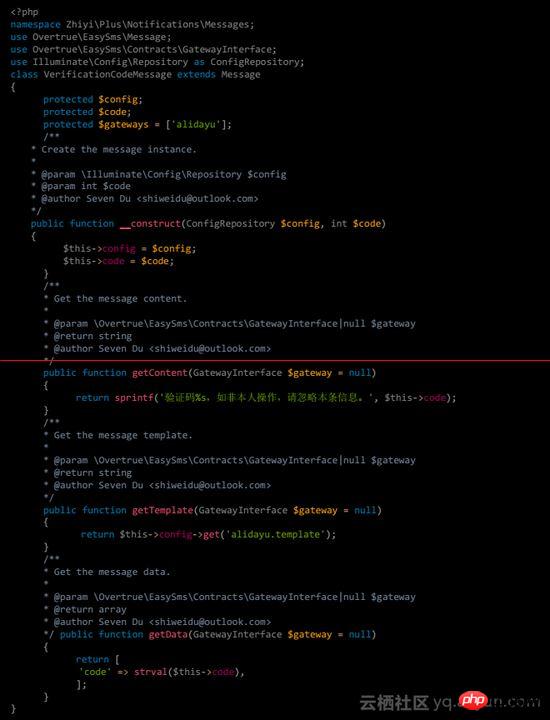
Then we return to the VerificationCode verification code notification class and add the toSms method. My code is as follows:

Scenario configuration, such as templates for different channels of verification codes, etc., so that the message server can determine the configuration of the usage scenario based on the sending gateway.
Complain again, the contract design of easy-sms should also have this idea, but getContent/getTemplate/getData does not pass the gateway at all when the actual gateway is called. . .
Okay, our development is completed.
Send verification code
It has been added to the "factory" when creating the verification code data model, so we can use the factory directly The function is complete, send the demo:
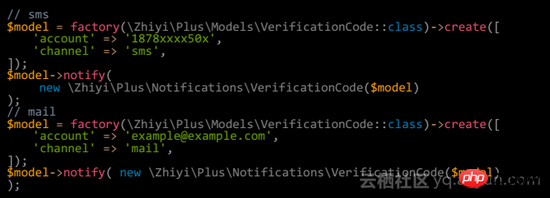
#You’re done, easy-sms is a very good package.
The above is the detailed content of 'Specifications' for developing SMS verification code sending function in Laravel (picture). For more information, please follow other related articles on the PHP Chinese website!

Hot AI Tools

Undresser.AI Undress
AI-powered app for creating realistic nude photos

AI Clothes Remover
Online AI tool for removing clothes from photos.

Undress AI Tool
Undress images for free

Clothoff.io
AI clothes remover

Video Face Swap
Swap faces in any video effortlessly with our completely free AI face swap tool!

Hot Article

Hot Tools

Notepad++7.3.1
Easy-to-use and free code editor

SublimeText3 Chinese version
Chinese version, very easy to use

Zend Studio 13.0.1
Powerful PHP integrated development environment

Dreamweaver CS6
Visual web development tools

SublimeText3 Mac version
God-level code editing software (SublimeText3)

Hot Topics
 1655
1655
 14
14
 1413
1413
 52
52
 1306
1306
 25
25
 1252
1252
 29
29
 1226
1226
 24
24
 Laravel Eloquent ORM in Bangla partial model search)
Apr 08, 2025 pm 02:06 PM
Laravel Eloquent ORM in Bangla partial model search)
Apr 08, 2025 pm 02:06 PM
LaravelEloquent Model Retrieval: Easily obtaining database data EloquentORM provides a concise and easy-to-understand way to operate the database. This article will introduce various Eloquent model search techniques in detail to help you obtain data from the database efficiently. 1. Get all records. Use the all() method to get all records in the database table: useApp\Models\Post;$posts=Post::all(); This will return a collection. You can access data using foreach loop or other collection methods: foreach($postsas$post){echo$post->
 Laravel Introduction Example
Apr 18, 2025 pm 12:45 PM
Laravel Introduction Example
Apr 18, 2025 pm 12:45 PM
Laravel is a PHP framework for easy building of web applications. It provides a range of powerful features including: Installation: Install the Laravel CLI globally with Composer and create applications in the project directory. Routing: Define the relationship between the URL and the handler in routes/web.php. View: Create a view in resources/views to render the application's interface. Database Integration: Provides out-of-the-box integration with databases such as MySQL and uses migration to create and modify tables. Model and Controller: The model represents the database entity and the controller processes HTTP requests.
 Solve caching issues in Craft CMS: Using wiejeben/craft-laravel-mix plug-in
Apr 18, 2025 am 09:24 AM
Solve caching issues in Craft CMS: Using wiejeben/craft-laravel-mix plug-in
Apr 18, 2025 am 09:24 AM
When developing websites using CraftCMS, you often encounter resource file caching problems, especially when you frequently update CSS and JavaScript files, old versions of files may still be cached by the browser, causing users to not see the latest changes in time. This problem not only affects the user experience, but also increases the difficulty of development and debugging. Recently, I encountered similar troubles in my project, and after some exploration, I found the plugin wiejeben/craft-laravel-mix, which perfectly solved my caching problem.
 Laravel user login function
Apr 18, 2025 pm 12:48 PM
Laravel user login function
Apr 18, 2025 pm 12:48 PM
Laravel provides a comprehensive Auth framework for implementing user login functions, including: Defining user models (Eloquent model), creating login forms (Blade template engine), writing login controllers (inheriting Auth\LoginController), verifying login requests (Auth::attempt) Redirecting after login is successful (redirect) considering security factors: hash passwords, anti-CSRF protection, rate limiting and security headers. In addition, the Auth framework also provides functions such as resetting passwords, registering and verifying emails. For details, please refer to the Laravel documentation: https://laravel.com/doc
 Laravel's geospatial: Optimization of interactive maps and large amounts of data
Apr 08, 2025 pm 12:24 PM
Laravel's geospatial: Optimization of interactive maps and large amounts of data
Apr 08, 2025 pm 12:24 PM
Efficiently process 7 million records and create interactive maps with geospatial technology. This article explores how to efficiently process over 7 million records using Laravel and MySQL and convert them into interactive map visualizations. Initial challenge project requirements: Extract valuable insights using 7 million records in MySQL database. Many people first consider programming languages, but ignore the database itself: Can it meet the needs? Is data migration or structural adjustment required? Can MySQL withstand such a large data load? Preliminary analysis: Key filters and properties need to be identified. After analysis, it was found that only a few attributes were related to the solution. We verified the feasibility of the filter and set some restrictions to optimize the search. Map search based on city
 Laravel framework installation method
Apr 18, 2025 pm 12:54 PM
Laravel framework installation method
Apr 18, 2025 pm 12:54 PM
Article summary: This article provides detailed step-by-step instructions to guide readers on how to easily install the Laravel framework. Laravel is a powerful PHP framework that speeds up the development process of web applications. This tutorial covers the installation process from system requirements to configuring databases and setting up routing. By following these steps, readers can quickly and efficiently lay a solid foundation for their Laravel project.
 Laravel and the Backend: Powering Web Application Logic
Apr 11, 2025 am 11:29 AM
Laravel and the Backend: Powering Web Application Logic
Apr 11, 2025 am 11:29 AM
How does Laravel play a role in backend logic? It simplifies and enhances backend development through routing systems, EloquentORM, authentication and authorization, event and listeners, and performance optimization. 1. The routing system allows the definition of URL structure and request processing logic. 2.EloquentORM simplifies database interaction. 3. The authentication and authorization system is convenient for user management. 4. The event and listener implement loosely coupled code structure. 5. Performance optimization improves application efficiency through caching and queueing.
 How to learn Laravel How to learn Laravel for free
Apr 18, 2025 pm 12:51 PM
How to learn Laravel How to learn Laravel for free
Apr 18, 2025 pm 12:51 PM
Want to learn the Laravel framework, but suffer from no resources or economic pressure? This article provides you with free learning of Laravel, teaching you how to use resources such as online platforms, documents and community forums to lay a solid foundation for your PHP development journey from getting started to master.



